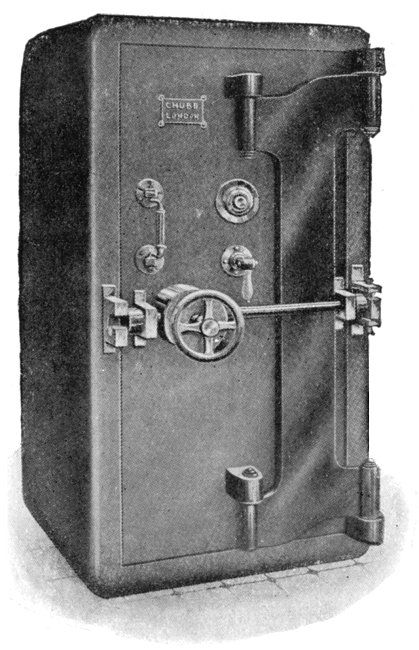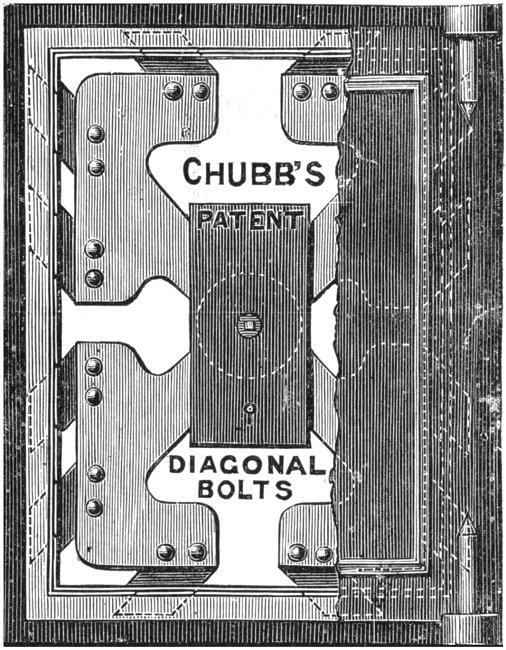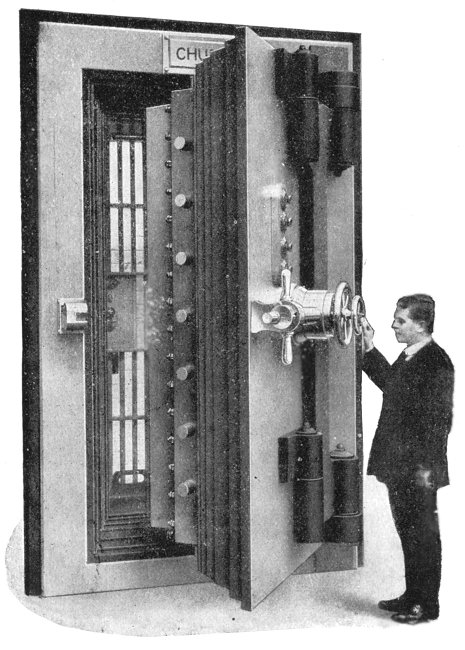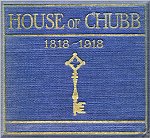|
From Coffer to Safe Deposit
From the wooden chest or coffer dug out
of a solid tree trunk or constructed of massive timbers,
which formed the early receptacle for valuables to the
latest safe deposit and treasury is a far cry. Those who
wish to study the evolution of the ancient wooden coffer and
its manifold forms should consult Mr. Fred Roe's intensely
interesting work "Early Coffers and Cupboards."
Our present
concern, however, is with metal receptacles. Perhaps the
form that approximated most closely to the modern safe, and
which has survived in considerable numbers, is the medieval
treasure chest, a large iron oblong box constructed of heavy
bands of metal and leaving a ponderous lock in the lid,
throwing many bolts under a flange round the mouth of the
chest. The interlaced bands of iron of which these chests
were constructed remind us that in those days the production
of iron steel sheets by rolling was, of course, unknown;
even the larger surfaces of armour, etc., were produced by
hammering out metal to the required thickness.
|

A modern Chubb patent anti-blowpipe safe,
fitted with a crane hinge and keyless lock. |
The keyholes of these chests were
ingeniously masked, and in certain cases the lock in the lid
was either supplemented or replaced by heavy hasps secured
by padlocks. Such chests are frequently found in muniment
rooms, in the halls of trade guilds and in museums; they are
of considerable strength, the complicated and finely
constructed bolt work and warded locks offering sturdy
resistance to the old time marauder. Indeed, in cases where
their large warded keys have been lost, the opening of such
chests has often been a lengthy process even for the latter
day locksmith. Most of these chests appear to be of foreign
construction, the covering plates of the lock work being in
many cases finely fretted and chased, while in other cases
decorative painting adds to their interest.
These and the later forms of iron chest
or safe, however massive, afforded little or no protection
against fire, and the necessity for receptacles giving some
measure of fire resistance resulted in the introduction of
various forms of proofed safes, the walls of which were
packed with certain substances designed to give off vapour
on being subjected to high temperature and assist in the
preservation of the contents of the safe.
The constructional
details of many of these early safes were open to criticism,
especially as regards the arrangement of the bolt work, and
the method of attaching the outer plates to the framework.
|
| Perhaps one of the most outstanding
improvements introduced by Chubb's was the diagonal bolt
system, which being first applied by them to locks about
1847, was later on improved and successfully applied to
safes and strong room doors, proving to be one of the most
effective arrangements ever devised for binding a safe or
strong room door to its body or frame.
The illustration below shows the manner in which the bolts, instead of
shooting straight from the door into their sockets or
flange, emerge diagonally and enter angular apertures
provided in the body of the safe or frame of door, knitting
the frame and door together with especial tenacity. Another
improvement was the substitution of round bent corners for
the rectangular safe corners formerly constructed, thus
preventing the insertion of wedges into the angle joints and
the wrenching off of the back of the safe, a favourite
method of the burglar in dealing with the commoner types of
safes, and sometimes attempted in the case of those of
leading makers |
| Some years ago it became the practice
to protect the locks of better class safes and strong room
doors by hard steel plates as a protection from drilling.
Later on compound drill resisting armour plate consisting of
alternate layers of steel and other metals of varying
hardness was used in the construction of the bodies of both
safes and rooms, special combinations of metal being devised
to counteract the use of the blowpipe, which had in many
instances been successfully employed in penetrating ordinary
plates by melting holes in them.
Among other recent innovations in safe
and door construction by Chubb's is the Stelocrete system,
by which use is made of a special form of ferro concrete,
which has proved singularly effective in the case of party
wall and other doors designed to prevent fire extending from
one building to another, the severe tests to which such
doors have been subjected having given most satisfactory
results. The system has also been applied with success to
the construction of safes. |

The diagonal bolt principle. |
|
Space prevents extended details of
these protective materials and devices, but brief reference
may be made to some of Chubb's more important strong room
work. A quarter of a century ago a sensation was created by
the production of a steel strong room of such dimensions
that its completion was celebrated by an extensive luncheon
party being accommodated in its capacious interior.
Rooms of far greater
dimensions are now regularly produced, and, with future
reduction of the Government's war requirements, will, no
doubt, increasingly occupy the Chubb factories. Some idea of
their strength may be gained from the fact that certain
recently constructed treasury doors alone have weighed, with
frame, nearly ten tons, yet so accurately are they poised on
their massive crane hinges that they can be moved by one
hand. |
|

Crane Hinge, Armour-Plated Strong Room
Door, weighing 6 tons. |
In such doors, keyholes, which might
afford an opportunity for the insertion of explosives, are
absent, the bolt work being controlled by keyless
combination locks and time locks fitted behind the massive
plates of the door and only allowing of the door being
opened after a certain prearranged hour, and then only on
the simultaneous attendance of three officials. All these
arrangements are designed to baffle the modern cracksman,
who presses into his criminal service a number of weapons
unknown to the burglar of a century ago.
Armed with modern
explosives and with the oxy-acetylene blowpipe, few indeed
are the safes of a past era that would provide any defence
against these tremendously potent modes of attack.
Chubb's
present day work, therefore, is directed towards the
construction of security work which can successfully defy
both nitro glycerine and the white heat temperatures of the
modern blowpipe and electric burning. |
|
Chubb's "Triple Treasury Construction"
with its indispensable adjunct, the crane hinge door,
constitutes the last word in security construction, and has
been proved to resist effectively even bombardment with
naval gun shells. Speaking broadly, this construction
consists of two steel strong rooms, one inside the other,
both built of Chubb's interlocking plates, the space between
being filled up with about a foot thickness of specially
armed concrete.
The many patented improvements designed
by Chubb's during the past 100 years indicate how they have
followed and countered the various wiles of the burglar by
protective methods born of their long experience. |
 |
|
 |
|
 |
Return to
Chapter 2 |
|
Return to
the contents |
|
Proceed to
Chapter 4 |
|